
Mysterious Stone Circles

Mysterious Stone Circles
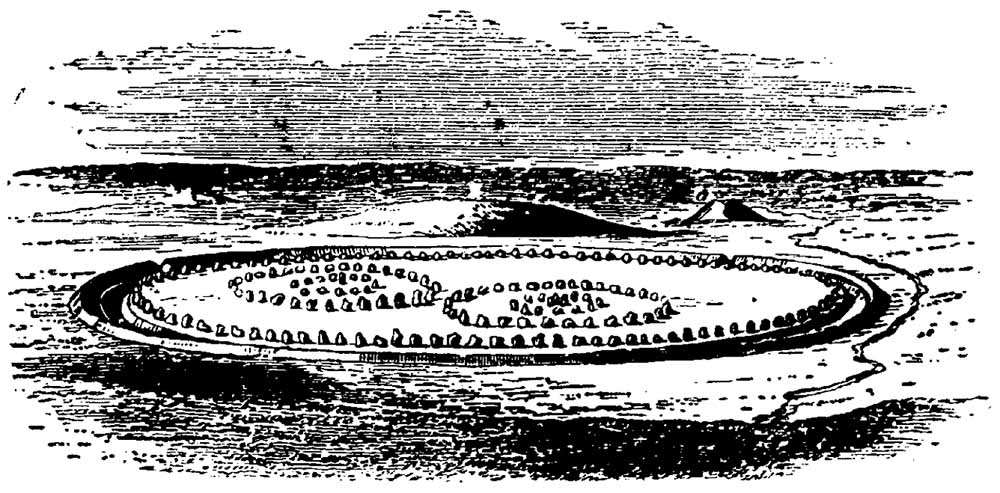
The postulated original layout of Avebury, published in a late 19th-century edition of the Swedish encyclopaedia Nordisk familjebok. Original illustration by John Martin, based on an illustration by John Britton
Avebury is the site of a large henge and several stone circles in the English county of Wiltshire surrounding the village of Avebury. It is one of the finest and largest Neolithic monuments in Europe dating to around 5,000 years ago. It is older than the megalithic stages of Stonehenge, which is located about 32 kilometres (20 mi) to the south, although the two monuments are broadly contemporary overall. It lies approximately midway between the towns of Marlborough and Calne, just off the main A4 road on the northbound A4361 towards Wroughton. The henge is a Scheduled Ancient Monument and a World Heritage Site.
Most of the surviving structure consists of earthworks known as the dykes, consisting of a massive ditch and external bank henge 421 metres (1,381 ft) in diameter and 1.35 kilometres (0.84 mi) in circumference. The only known comparable sites of similar date (Stonehenge and Flagstones in Dorset) are only a quarter of the size of Avebury. The ditch alone was 21 metres (69 ft) wide and 11 metres (36 ft) deep, with its primary fill carbon dated to between 3400 and 2625 BC.
A later date in this period is more likely although excavation of the bank has demonstrated that it has been enlarged, presumably using material excavated from the ditch. The fill at the bottom of the final ditch would therefore post-date any in an earlier, shallower ditch that no longer exists.
Within the henge is a great Outer Circle constituting prehistory's largest stone circle with a diameter of 335 metres (1,099 ft). It was contemporary with or built around four or five centuries after the earthworks. There were originally 98 sarsen standing stones some weighing in excess of 40 tons. They varied in height from 3.6 to 4.2 m as exemplified at the north and south entrances. Carbon dates from the fills of the stoneholes date between 2800 and 2400 BC.
Nearer the middle of the monument are two other, separate stone circles. The Northern inner ring measures 98 metres (322 ft) in diameter, although only two of its standing stones remain with two further, fallen ones. A cove of three stones stood in the middle, its entrance pointing northeast.
The Southern inner ring was 108 metres (354 ft) in diameter before its destruction. The remaining sections of its arc now lie beneath the village buildings. A single large monolith, 5.5 metres (18 ft) high, stood in the centre along with an alignment of smaller stones until their destruction in the eighteenth century. There is an avenue of paired stones, the West Kennet Avenue, leading from the south eastern entrance of the henge and traces of a second, the Beckhampton Avenue lead out from the western one.
Aubrey Burl conjectures a sequence of construction beginning with the North and South Circles erected around 2800 BC, followed by the Outer Circle and henge around two hundred years later and the two avenues added around 2400 BC.
A timber circle of two concentric rings, identified through archaeological geophysics possibly stood in the northeast sector of the outer circle, although this awaits testing by excavation. A ploughed barrow is also visible from the air in the northwestern quadrant. The henge had four entrances, two opposing ones on a north by northwest and south by southeast line, and two on an east by northeast and west by southwest line.
Despite being a man-made structure, it was featured on the 2005 TV programme Seven Natural Wonders as one of the wonders of the West Country because it consists of natural components.
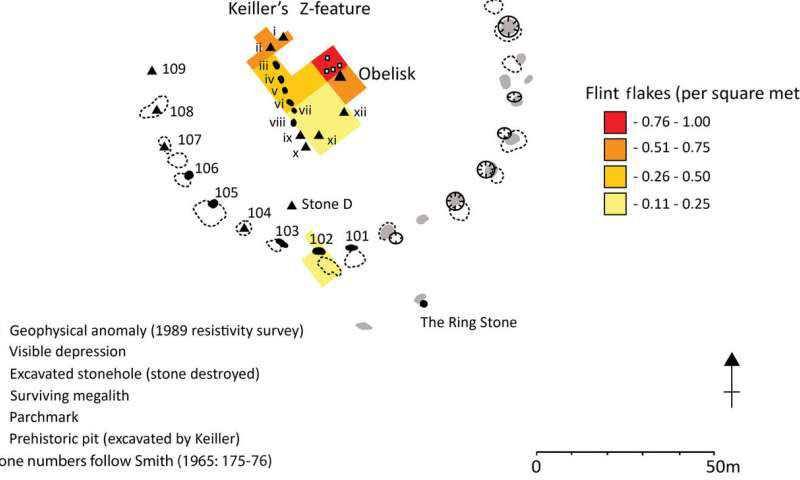
New study of Avebury monument suggests it started out as a single-family home PhysOrg - April 12, 2019
A trio of researchers from the University of Leicester and the University of Southampton has found evidence that suggests the Avebury monument might have started out as a single-dwelling home. The Avebury monument is a Neolithic site situated approximately 20 miles from the more famous monument Stonehenge. Like Stonehenge, Avebury is made mostly of large stones. In the case of Avebury, the stones are smaller and spread wider. The monument consists of both standing stones and other stones arranged in circles. There is also a much larger ring of stones encircling the other stone structures, which is itself encircled by an embankment. No one knows why the monument was built, though, as with Stonehenge, there are many theories. The site has not been excavated since the 1930s and is now designated as a World Heritage Site. In this new effort, the researchers sought to learn more about the monument by using modern technology rather than digging.
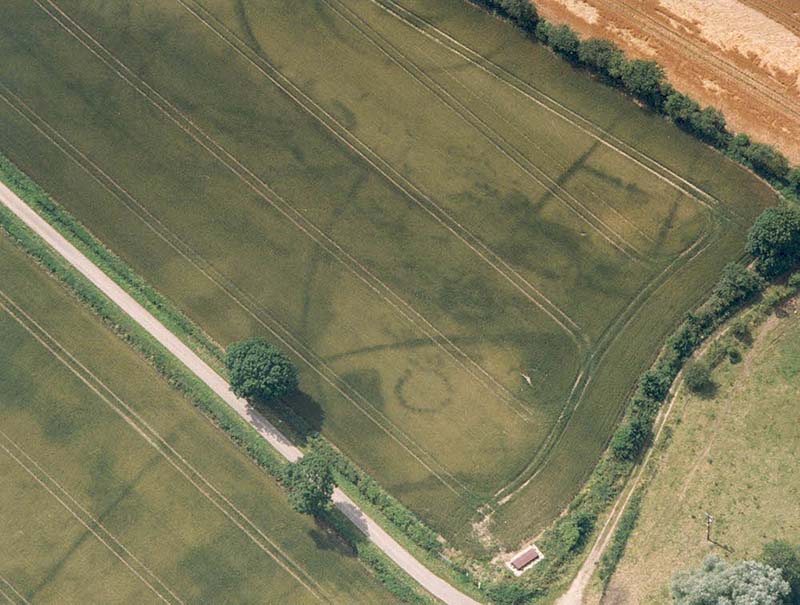
Mysterious Fire Monument in England Predates Stonehenge by 800 Years Live Science - June 8, 2017
A massive, wooden, eyeglass-shaped monument in Avebury, England, that was set alight in ancient ceremonies may be 800 years older than it was thought to be, new research suggests. The monument, which consists of two huge, circular enclosures - each outlined by tall, wooden posts - is about 5,300 years old, meaning the structure predates the first stones erected at nearby Stonehenge by about 800 years, the study found. Though the exact purpose of the Avebury monument is still shrouded in mystery, archaeologists think the two wooden circles were used for only a short time for a ceremony or festival before burning to the ground.
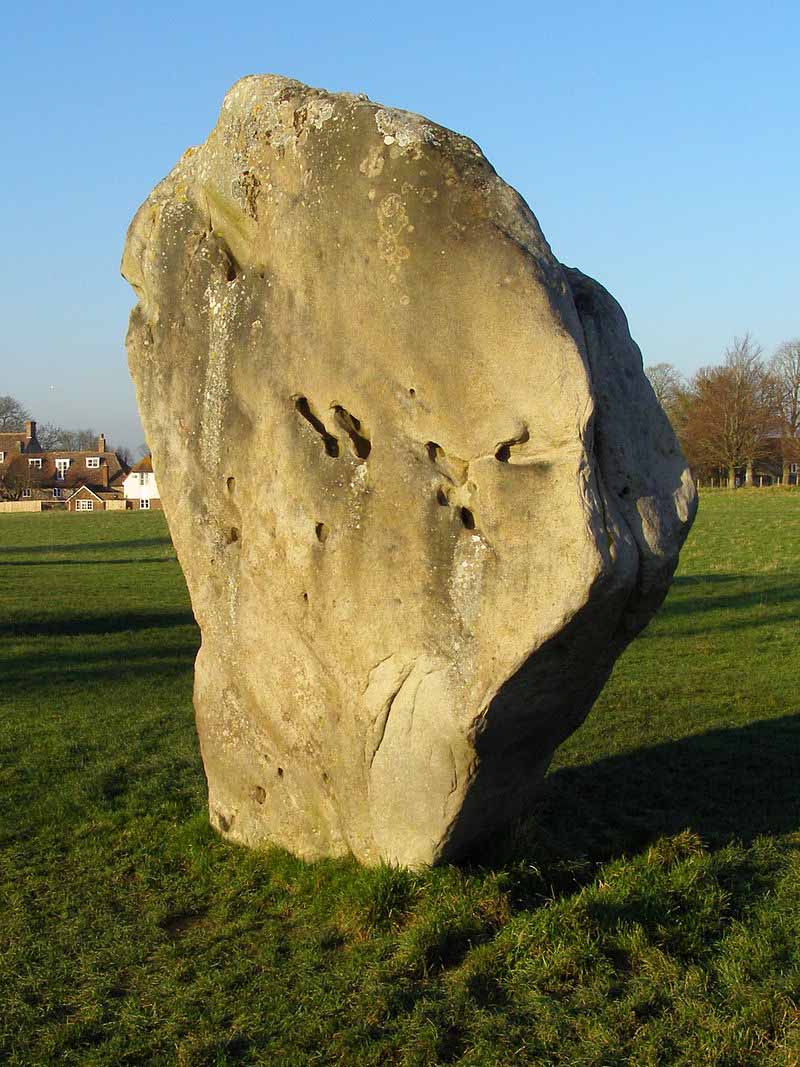
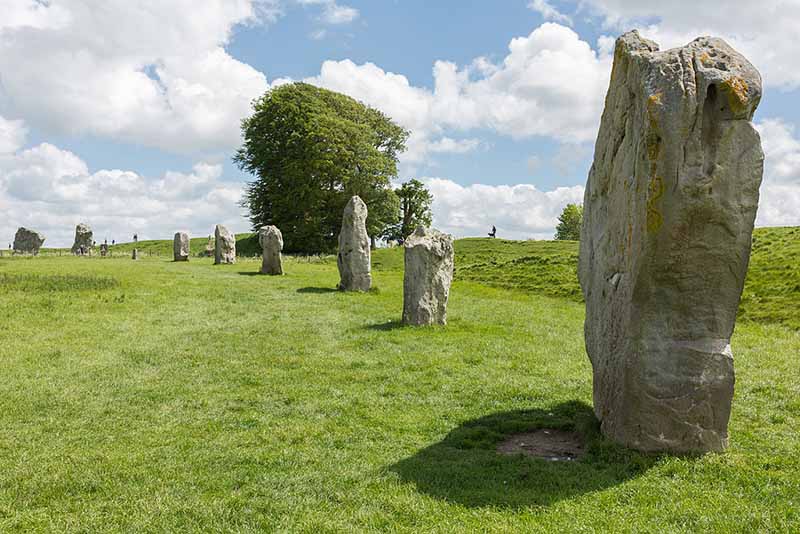
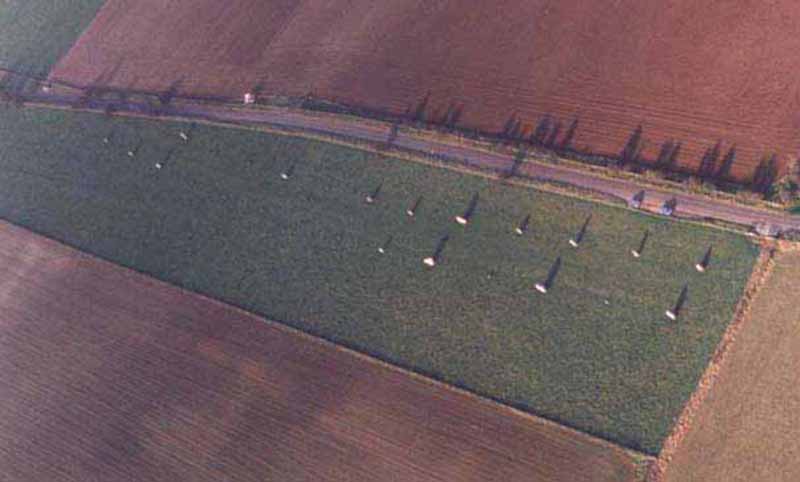
West Kennel Avenue
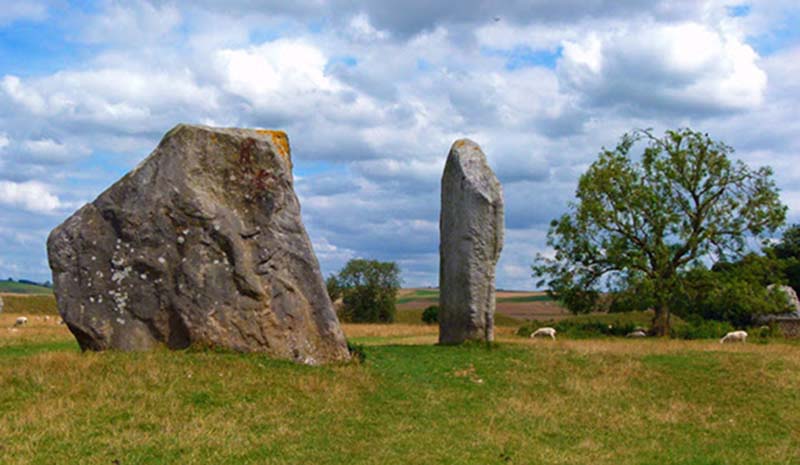
Adam and Eve Stones at the Avebury Stone Circle
Circle was set up by Bronze Age peoples
c.1800BC, 200 years - earlier than Stonehenge.
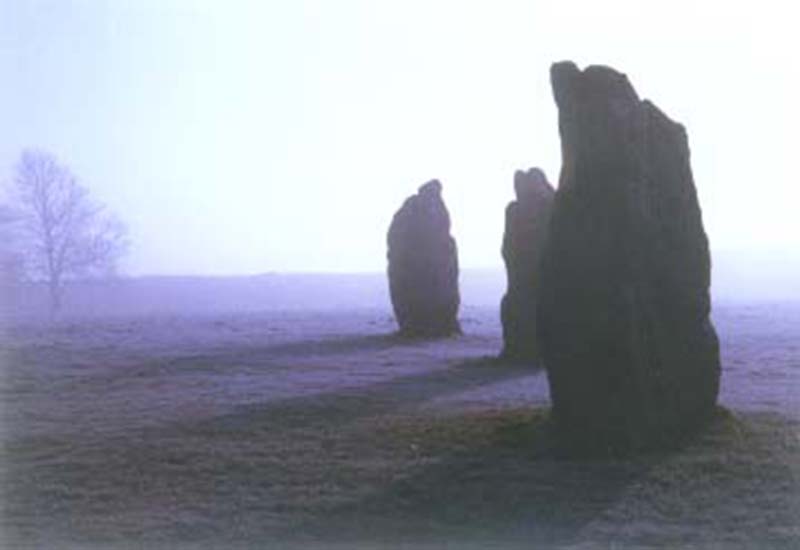
Misty Avebury Stones. About 100 great sarsen stones
and local sandstone from Marlborough Downs, still stand.
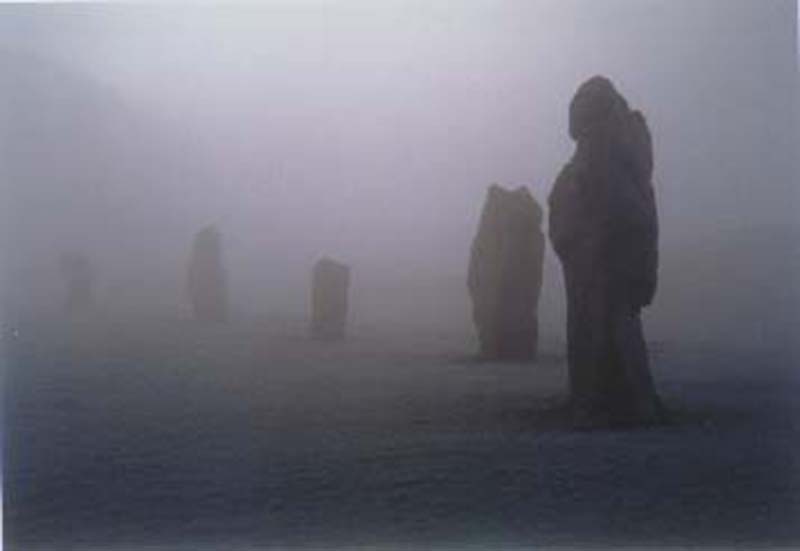
Merlin Stone at Avebury. This village is ringed by one
of the most important prehistoric monuments in Britain.
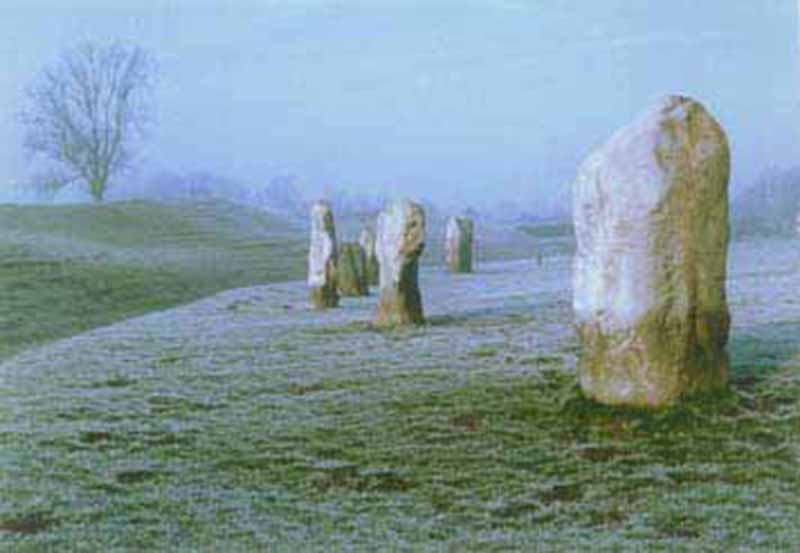
Avebury Stone Circle, Wiltshire, England was regarded by
many experts as the most important early Bronze Age.
It has only been since the twentieth century that the name of the village of Avebury and the earthwork have been synonymous. The earliest written mention of the earthwork is from the thirteenth century, when it is referred to as waledich. In 1696, it was referred to as wallditch. These names are Anglo-Saxon in origin and probably mean "ditch of the wealas." "Wealas" being a word used by Anglo-Saxon colonists to describe an enclave of native Britons.
Many of the original stones were destroyed from the early 14th century onwards[4] to provide local building materials and to make room for agriculture. The stones were also destroyed due to a fear of the pagan rituals that were associated with the site. Both John Aubrey and later, William Stukeley visited the site and described the destruction. Stukeley spent much of the 1720s recording what remained of Avebury and the surrounding monuments.
Only 27 stones of the Outer Circle survive and many of these are examples re-erected by Alexander Keiller in the 1930s. Concrete pylons now mark the former locations of the missing stones and it is likely that more stones are buried on the site. English Heritage is currently considering whether to dig up and re-erect these stones.
Excavation at Avebury itself has been limited. Sir Henry Meux put a trench through the bank in 1894, which gave the first indication that the earthwork was built in two phases.
The site was surveyed and excavated intermittently between 1908 and 1922 by a team of workmen under Harold St George Gray. He was able to demonstrate that the Avebury builders had dug down 11 metres (36 ft) into the natural chalk in excavating the henge ditch, producing an outer bank 9 metres (30 ft) high around the whole perimeter of the henge and using red deer antler as their primary digging tool.
Gray recorded the base of the ditch as being flat and 4 metres (13 ft) wide although some later archaeologists have questioned his use of untrained labour to excavate the ditch and suggested that its form may have been different. Gray found few artefacts in the ditch fill but did recover scattered human bones, jawbones being particularly well represented. At a depth of about 2 metres (7 ft), Gray encountered a complete skeleton of a woman 1.5 metres (5 ft) tall who had been buried there.
Archaeologist Alexander Keiller re-erected many of the stones during the 1930s. Under one, now known as the Barber Stone, the skeleton of a man was discovered. Coins found with him dated from the 1320s, and the evidence suggests that he was fatally injured while digging the burial pit for the stone when it fell on top of him. As well as the coins, he was found with a pair of scissors and a lancet, the tools of a barber-surgeon at that time, hence the name given to the stone. When a new village school was built in 1969 there was also limited further opportunity to examine the site and an excavation to produce carbon dating material and environmental data was undertaken in 1982.
The sequence of excavations has been examined by Dr Joshua Pollard in a series of volumes about Avebury.
A great deal of interest surrounds the stones at the monument which people describe often as being in one of two categories; tall and slender, or short and squat. This leads to numerous theories relating to the importance of gender in Neolithic Britain with the taller stones considered 'male' and the shorter ones 'female'. The stones were not dressed in any way and may have been chosen for their pleasing natural forms. Numerous people have identified what they claim are carvings on the stones' surfaces, some carvings being more persuasive than others.
The human bones found by Gray point to some form of funerary purpose and have parallels in the disarticulated human bone often found at earlier causewayed enclosure sites. Ancestor worship, although on a huge scale, could have been one of the purposes of the monument and would not be mutually exclusive with any male/female ritual role.
The henge, although clearly forming an imposing boundary to the circle, has no defensive purpose as the ditch is on the inside. Being a henge and stone circle site, astronomical alignments are a common theory to explain the positioning of the stones at Avebury.
The relationships between the causewayed enclosure, Avebury stone circles and, further south, West Kennet long barrow has caused some people to term this area a ritual complex - that is, a site with many monuments of interlocking religious function.
A large part of the small village of Avebury, complete with public house, is enclosed within the monument. Two local roads intersect within the monument, and visitors can walk on the earthworks.
The two stone avenues (Kennet Avenue and Beckhampton Avenue) that meet at Avebury define two sides of triangle that is designated a World Heritage site and which includes The Sanctuary, Windmill Hill, Silbury Hill and the West Kennet Long Barrow.
Avebury is seen as a spiritual centre by many who profess beliefs such as Paganism, Wicca, Druidry and Heathenry, and indeed for some it is regarded more highly than Stonehenge. The pagan festivals all attract visitors, and the summer solstice especially draws increasingly large crowds from the religious to the idly curious. Avebury is said to stand on the St Michael ley line, an alignment that goes across England from Cornwall to East Anglia.
As with Stonehenge, though, access regarding both interpretation and physical presence is contested. While Avebury henge and circles are 'open' to all, access has been controlled through closure of the car park. Pressure of numbers on this circle is an issue begging resolution, and various attempts at negotiation are underway. Avebury is increasingly important for tourism today, and how visitors relate to Avebury is part of the study of the Sacred Sites, Contested Rites/Rights project.
The National Trust, who steward and protect the site (owned by English Heritage) are also actively in dialogue with the Pagan community, who use the site as a religious temple or place of worship. This dialogue takes place through the National Trust's Avebury Sacred Sites Forum. The project has a charter and guidelines for visitors, which helps to foster understanding between the Pagan community and the general public visiting the site. Read more ...
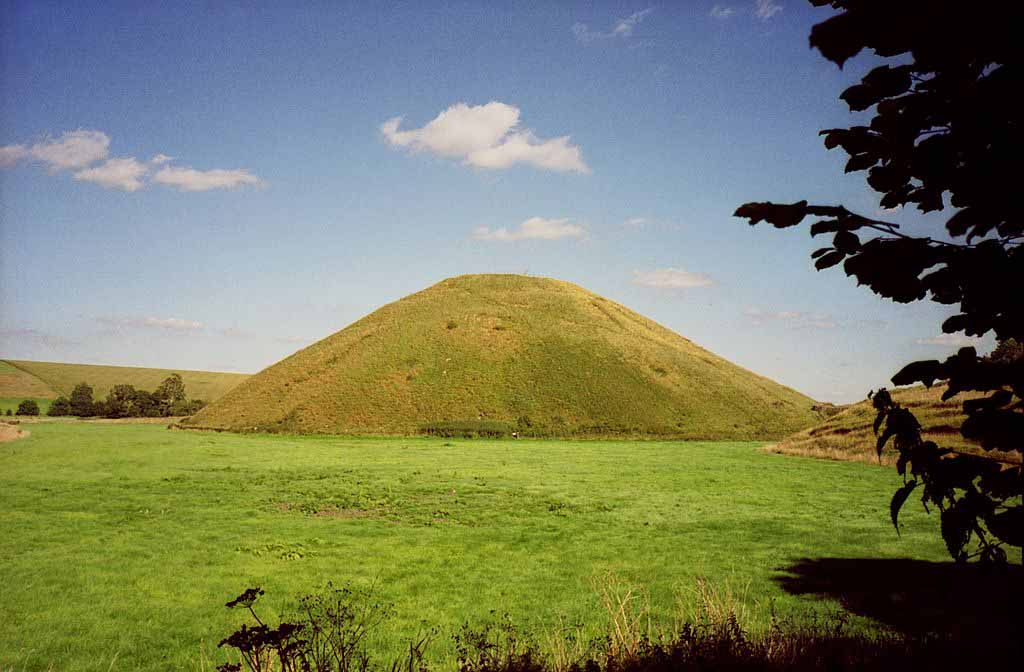
Silbury Hill in Avebury